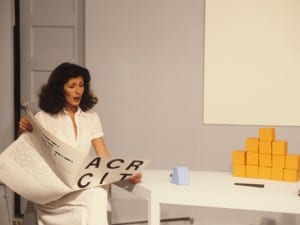Review by Sarah Richter, a candidate for the MA in Art History at Richmond the American International University in London.
Daisy Boman’s second exhibition entitled Encounter featured 20 new works from the Tahrisquare series which was inspired by the recent events in Egypt. The defining feature of Boman’s oeuvre of work is the presence of her Bo-Men. All of these small, pocket-sized, faceless figures are hand made of clay by the artist without faces or differentiating identities. But over time, and during the process of creation, each figure acquires different cracks or marks of exposure that lends them uniqueness similar to the burden each person carries. Even within their anonymity, they are unified. All white in colour, there is no distinction between them because in the end, race should not matter and thus the colour is blank. Unified by their anonymity, they are additionally united by their square blockheads. The presence of these square heads further represents that we are each products of the same mould; the one society has deemed we should live in. These figures of Boman’s creation visually represent the binding thread of humanity and ask to be seen for what they are, not who they are, proving that we aren’t as separate as we think we are.
The Bo-Men are individualized in their unity, as they are each in a diverse variety of poses: sitting, standing, cheering, helping, watching, jeering or offering support. They can be viewed as helping or hindering each other and their actions are positive and negative, much like those of humanity. The common theme of each of Boman’s pieces is that all of her figures are moving upwards, striving towards a common goal or purpose. Rather than allow for their personal appearance of identification to define the work, the individual movements and actions of the Bo-Men in the situations that they are in, speaks for itself and defines the work as an expression of the simplicity of existence. As the Bo-Men traverse the surfaces on which they exist, the propel forward and upward while performing a variety of activities that often times break the expected limits of the picture plane. By breaking with the conventions of containment as applied to the production of art, Boman allows for her Bo-Men to come to life. In each of the pieces, the Bo-Men have given simple, minimalist obstacles to overcome and assist them on their journey from ladders to ropes and metal posts to assist with the climb, they always work together, watching out for each other and assisting with the task at hand.
In Anytime, Anywhere the ‘Bo-Men’ work together to assist each other in climbing up a ladder to reach the ledge of the picture plane. The figures can be seen as struggling against one another, but also helping to strive for the common goal and reach their unknown destination. There is a sense of struggling for the self, but also overcoming that selfish desire to work together, despite differences to achieve success through unity and climb the ladder. The ladder serves as a symbol of ascension, progress and achieving a goal, but also can symbolize a search for something outside of the material world. Ladders, grounded in the earth, reach upward, towards a spiritual, unknown realm and in doing so, the search for something more than the world consumerism has created for us is possible and possible just there, up the ladder and over the wall. And it is this message of ascension and hope that the Bo-Men, not only in this piece, but also in every piece, provide and convey.
Within these figures, there is a sense of utopia, what could be in a world where race, religion, beliefs or not, convictions and ideas no longer matter as we can see that we aren’t really as different as we believe we are. All striving towards the same common goals and desires, it is only through distinctions of humanity’s own creation that we separate ourselves. The Bo-Men, beautiful in their place as relief sculptures in the walls of a gallery, but the entire exhibition of Boman’s work is mean to teach us about ourselves and the struggles we are always attempting to overcome. Every day is a struggle to survive, to persevere, to achieve, to succeed or even to just get by. Even with the rather negative inspiration for the pieces being that of racism and violence, there is a sense of hope in humanity present in the work. As the figures struggle together, they seem to watch over one another, as they, like us, carries the burden of life in their being. The unified theme of moving upwards is a beacon of hope, and reminder to us all, that through uniting ourselves, we can achieve something better.
Daisy Boman, Encounter ran from 24 June – 7 July. Currently on show at Halcyon Gallery is Modern Master Prints and Works on Paper until 12 August.
halcyongallery.com
daisyboman.co.uk
Aesthetica Magazine
We hope you enjoying reading the Aesthetica Blog, if you want to explore more of the best in contemporary arts and culture you should read us in print too. In the spirit of celebration, Issue 41 includes a piece on Guggenheimn Bilbao where the Luminous Interval features internationally acclaimed artists such as Louise Bourgeois, Kiki Smith and Damien Hirst, ArtAngel’s new commission at MIF, Bruce Nauman’s retrospective at The Kunsthalle Mannheim and Cory Arcangel’s Pro Tools at the Whitney in NYC. You can buy it today by calling +44(0)1904 479 168. Even better, subscribe to Aesthetica and save 20%. Go on, enjoy!
Image:
Democratie – Tahrirsquare 4 (2011) (Detail)
Daisy Boman
Ceramic, Acrylic case
40 x 40 x 40 cm
Courtesy of Halcyon Gallery





